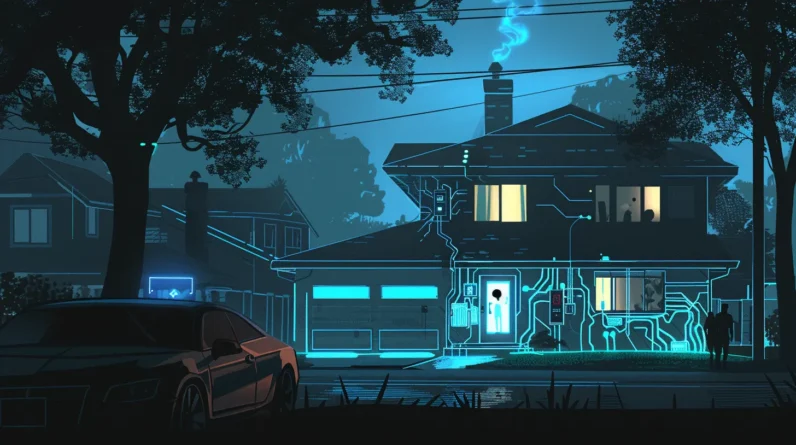
As we increasingly rely on smart home devices to control our living spaces, it’s like having a personal assistant at our beck and call. But, have we paused to ponder the implications of this convenience? While smart home technology unquestionably offers benefits like energy efficiency and enhanced security, it also raises concerns about our growing dependency on it. As we surrender more tasks to automation, what happens to our traditional skills and sense of self-sufficiency? And what about the potential risks lurking in the shadows of our connected homes? Let’s take a closer look at the trade-offs we’re making.
Convenience and Automation Benefits
Moreover, integrating smart home technology into our daily lives can lead to a significant enhancement in convenience and automation, enabling us to control and monitor various aspects of our homes remotely.
We can adjust the thermostat, turn on lights, and even lock doors with just a few taps on our smartphones. This level of control not only saves us time but also provides us with peace of mind, knowing that our homes are secure and comfortable.
Furthermore, smart home devices can learn our habits and preferences, automating tasks and making our lives easier. With smart home technology, we can enjoy a more streamlined and stress-free living experience.
Energy Efficiency and Cost Savings
We can also reap significant energy efficiency and cost savings benefits from smart home technology. It enables us to optimize our energy consumption and reduce wastage. For instance, smart thermostats learn our schedules and preferences to regulate heating and cooling, minimizing energy usage when we’re not home or sleeping.
Similarly, smart lighting systems adjust brightness and color based on the time of day, occupancy, and ambient light. These automated adjustments lead to substantial reductions in energy consumption, resulting in lower utility bills and a reduced carbon footprint.
Enhanced Security and Safety Features
Smart home technology also bolsters our sense of security and safety with features that detect and respond to potential threats, from smoke and carbon monoxide to intruders and water damage. We can rest easier knowing that our homes are being monitored and protected 24/7.
Some of the key security and safety features include:
1. Intruder detection: Smart doorbells and motion sensors alert us to potential intruders, allowing us to take action before they enter our homes.
2. Smoke and carbon monoxide detection: Smart detectors alert us to potential fires and gas leaks, giving us time to evacuate and call for help.
3. Water leak detection: Smart sensors detect water leaks, preventing costly damage and potential electrical hazards.
4. Emergency response: Smart home systems can automatically alert emergency services in the event of a threat, ensuring a rapid response.
Increased Dependency on Technology
As we increasingly rely on smart home technology to manage our daily lives, it’s important to acknowledge that this convenience comes with a price: our growing dependence on technology.
We’re becoming so accustomed to having everything at our fingertips that we’re starting to lose basic skills. We’re forgetting what it’s like to navigate without GPS, to remember phone numbers, or to perform simple math calculations.
Our reliance on technology is making us lazy, and it’s affecting our problem-solving abilities. We’re sacrificing our independence for the sake of convenience, and that’s a concerning trade-off.
As we continue to integrate smart home technology into our lives, it’s essential that we’re aware of this dependency and make an effort to maintain a balance between technology and traditional skills.
Cybersecurity Risks and Vulnerabilities
Beyond the concerns of dependency, our digital footprints within smart homes also expose us to a multitude of cybersecurity risks and vulnerabilities. As we increasingly rely on connected devices, we’re creating a vast attack surface for hackers. This is particularly concerning, given that many smart home devices lack robust security features.
Here are some key risks to bear in mind:
1. Unsecured devices: Many smart home devices have weak passwords or no encryption, making them easy targets for hackers.
2. Data breaches: Smart home devices can collect and store sensitive data, which can be compromised in the event of a breach.
3. Malware and ransomware: Hackers can use smart home devices as entry points to inject malware or ransomware into our networks.
4. Privacy concerns: Smart home devices can collect and share our personal data with third parties, raising concerns about privacy and surveillance.
It’s essential that we take steps to mitigate these risks and ensure our smart homes are secure and protected.
High Upfront and Maintenance Costs
We must also consider the significant financial burden of investing in smart home technology, which comes with high upfront costs and ongoing maintenance expenses. The initial investment in smart devices, hubs, and installation can be substantial.
Moreover, we’ll need to factor in the cost of replacing devices as they become outdated or malfunction. Smart home systems often require regular software updates, which can be time-consuming and may even require professional assistance, adding to the overall expense.
While smart home technology offers many benefits, we must carefully weigh these costs against the advantages to make sure it’s a worthwhile investment for our household.
Conclusion
As we weigh the benefits and drawbacks of smart home technology, it’s clear that convenience, energy efficiency, and enhanced security features have revolutionized the way we live. Yet, we can’t ignore the risks of dependency, cybersecurity threats, and high costs.
Strikingly, the same technology that brings us comfort and peace of mind can also make us vulnerable. It’s up to us to find a balance, embracing the advantages while mitigating the disadvantages, to create a harmonious and secure living space that truly feels like home.







